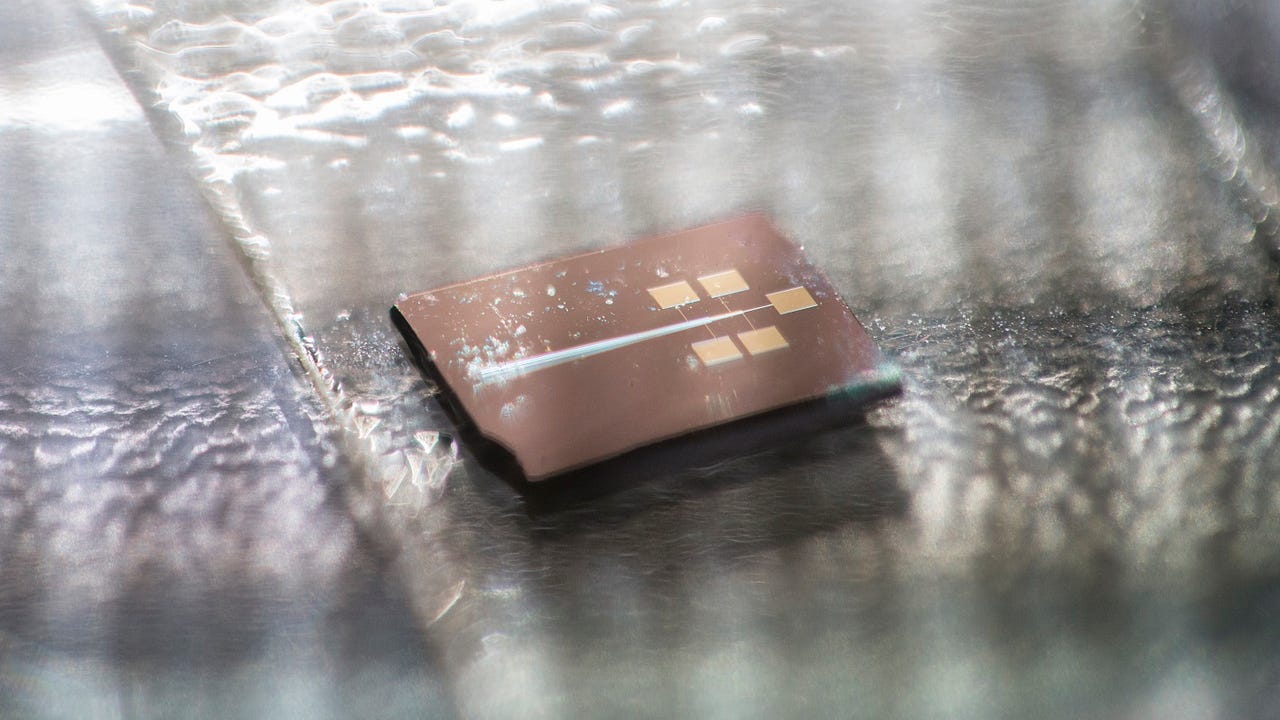ANU develops part-organic semiconductor


The semiconducting material sits in between gold electrodes on the pictured chip. The 1cm x 1cm chip can hold close to a thousand transistor circuits.
The Australian National University (ANU) has announced the invention of a part-organic semiconductor by a team of engineers, touting the development as paving the way for bendable devices, such as mobile phones.
The thin and flexible semiconductor is comprised of both organic and inorganic materials that ANU said can convert electricity into light very efficiently.
ANU explained the organic component of the semiconductor has the thickness of just one atom and is made from just carbon and hydrogen. The inorganic component has the thickness of around two atoms.
The hybrid structure can convert electricity into light efficiently for displays on mobile phones, televisions, and other electronic devices, the university said.
PhD researcher at the ANU Research School of Engineering Ankur Sharma said experiments with the semiconductor demonstrated its performance would be much more efficient than conventional semiconductors made with inorganic materials such as silicon.
"We have the potential with this semiconductor to make mobile phones as powerful as today's supercomputers," Sharma said. "The light emission from our semiconducting structure is very sharp, so it can be used for high-resolution displays and, since the materials are ultra-thin, they have the flexibility to be made into bendable screens and mobile phones in the near future."
The team grew the organic semiconductor component molecule by molecule, in a similar way to 3D printing, using a process called chemical vapour deposition, it explained.
"We characterised the opto-electronic and electrical properties of our invention to confirm the tremendous potential of it to be used as a future semiconductor component," Associate Professor Lu from the ANU Research School of Engineering added. "We are working on growing our semiconductor component on a large scale, so it can be commercialised in collaboration with prospective industry partners."
With e-waste a growing concern for technology giants, ANU said the invention also opens the door to a new generation of high-performance biodegradable -- or at least easily recyclable -- electronic devices.
"The huge volumes of e-waste generated by discarded electronic devices around the world is causing irreversible damage to the environment," ANU said. "Australia produces 200,000 tonnes of e-waste every year -- only four percent of this waste is recycled."
Read also: CSIRO: Lithium-ion battery waste to exceed 100,000 tonnes by 2036
ANU on Friday also announced a group of its researchers have found a way to cancel out the noise produced by things like motors and air conditioning units, using a similar concept to the technology used in noise cancellation headphones.
The university said the process involves using multiple microphones and loudspeakers to override the original noise source with a second sound. ANU said it works effectively on any noise with a lower frequency, but that high frequency noises present a bigger challenge as the wave length is very small, requiring multiple microphones and loudspeakers.
"What we're looking at is cancelling the sound over an extended region, without wearing headphones. That's a much more difficult and complex task because it's not just confined to the ear cup, and things reflect back from walls and around rooms," Professor Thushara Abhayapala from the Research School of Engineering at ANU said.
"We've come up with a technique to separate the sound going out from the sound coming in, and actually cancel the sound going out. No matter where you are around it, you get the reduced noise level."
Another team of ANU researchers last week announced alongside Tohoku University in Japan they had found a new way of dealing with space junk, using a new type of satellite powered by superheated gas.
ANU said a satellite could be sent up to seek out and shift this debris, by shooting out a beam of hot plasma -- or ionised gas -- from the opposite end of the satellite. This would allow the satellite to push the space junk down into a lower orbit so it eventually decays, or push it up to get it out of the way of other objects, the university explained.
READ ALSO
- Begone, silicon: New semiconductors touted as the future for our chips
- Researchers turn to sound to speed up photonic chips
- Australian National University invention brings sci-fi holograms a step closer
- ANU touts tiny camera lens for quantum information transfer
- Australian National University invention brings sci-fi holograms a step closer
- Stopping light a quantum leap for ANU
- Why Facebook designing its own chips could help it compete with Apple, Google (TechRepublic)